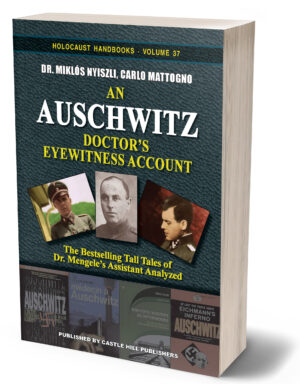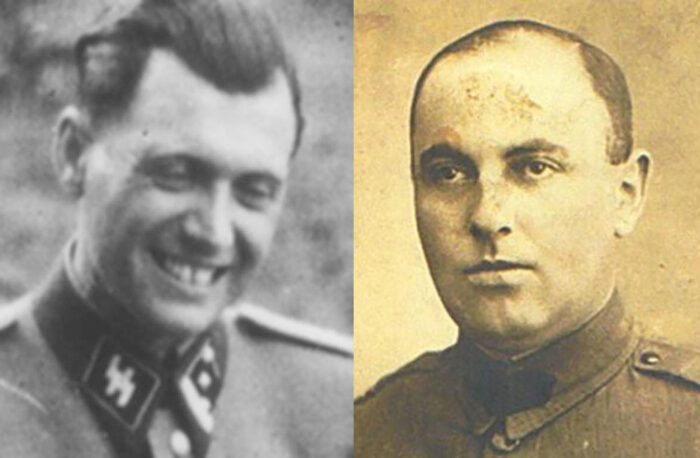An Auschwitz Doctor’s Eyewitness Account
Book Announcement
Carlo Mattogno, Myklós Nyiszli, An Auschwitz Doctor’s Eyewitness Account: The Bestselling Tall Tales of Dr. Mengele’s Assistant Analyzed, Castle Hill Publishers, Uckfield, 2018, 474 pages, 6”×9” paperback, b&w illustrated, bibliography, index, ISBN 978-1-59148-193-5. Online at holocausthandbooks.com/book/an-auschwitz-doctors-eyewitness-account/
The tall tales told by the Jewish-Hungarian physician Miklós Nyiszli about his alleged experiences during the war while in German captivity at Auschwitz have been very influential for the post-war development of the orthodox Holocaust narrative. For instance, Nyiszli’s descriptions of what he claims to have experienced as Mengele’s assistant have been one of the mainstays in the formation of the Mengele Myth.[1]
Although Nyiszli’s postwar booklet even became the basis of the 2003 movie The Grey Zone, his name is basically unknown to most, quite in contrast to Rudolf Höss or Josef Mengele. The historical orthodoxy has always blindly accepted Nyiszli’s narrative, with no healthy source skepticism, let alone criticism, anywhere in sight, as proper historical scholarship requires.
Already in 1988, revisionist historian Carlo Mattogno filled this research desideratum by publishing a critical analysis of Nyiszli’s account in a small Italian book.[2] When we urged him a few years ago to expand his writing activities to encompass witness testimony by thoroughly criticize key witness accounts, he was at first reluctant to do so. Throughout his career as a historian, Carlo has always insisted that historiography must give material and documental evidence priority over anecdotal evidence. While we agree with this tenet, witness tales still have a huge influence on the general populace’s perception of claimed Holocaust events. If they were there and lived through it, how can anyone who was not there doubt them? Meanwhile, Holocaust survivors have been elevated to the status of saints, and the masses tend to believe anything they claim. It is therefore both very difficult, politically speaking, as well as important, scientifically speaking, to subject these survivor tales to careful scrutiny, because a mixture of gullibility, sensationalism and veneration of saints on part of the world’s audiences has virtually been begging these witnesses to tell cliché-riddled sensational stories brimming with distortions, inventions and exaggerations.
 Eventually, Carlo consented to take his 1988 study as a starting point for a much more thorough work. When he finally submitted it for translation, however, we faced a formidable challenge: The text was a mixture of Carlo’s Italian text, a multitude of quotes in various languages (mainly German, French, English) plus Nyiszli’s original Hungarian text.
Eventually, Carlo consented to take his 1988 study as a starting point for a much more thorough work. When he finally submitted it for translation, however, we faced a formidable challenge: The text was a mixture of Carlo’s Italian text, a multitude of quotes in various languages (mainly German, French, English) plus Nyiszli’s original Hungarian text.
Since existing published English translations of Nyiszli’s text were copyrighted and turned out to be unreliable, we decided to have Nyiszli’s entire book translated from scratch. Finding a competent bilingual Hungarian-English translator willing to contribute to this revisionist project was difficult, but one volunteer came forward, for which we are very grateful.
In late 2017, after a long struggle, the work was finally brought onto the home stretch, and was ultimately released in February of 2018. It was overtaken by Carlo’s book on Rudolf Höss,[3] which he had started writing after having submitted his Nyiszli typescript. Carlo’s book on Höss also has its roots in a much older and smaller study he had published a year prior to his study on Nyizli, in 1987.[4]
Everyone knows Dr. Josef Mengele, the evil Auschwitz doctor who sent countless Jews to the gas chambers, performed cruel, pointless medical experiments on inmates, and gave twin research a bad reputation. But how do we “know” about his many diabolical deeds?

The most important source for what Mengele is said to have done at Auschwitz comes from the Hungarian Jew Miklós Nyiszli, a forensic physician who claims to have been Dr. Mengele’s assistant at Auschwitz. In 1946, he published a book about his traumatic experiences while he was at Auschwitz. Over the years, his book has been translated into all major languages of Europe. It has become one of the mainstays of the orthodox Auschwitz narrative, right next to the testimonies of other key witnesses, such as that of the former Auschwitz commandant Rudolf Höss, or of Elie Wiesel.
As influential as Nyiszli’s book has been in forming the world’s opinion about Auschwitz, Nyiszli’s various writings have never been subjected to thorough critical scrutiny. The present book changes this.
Part 1 of this book contains a faithful translation of the original 1946 edition of Nyiszli’s Hungarian book, while Part 2 makes publicly accessible for the first time essential excerpts of much-less known postwar texts by and about Nyiszli.
Part 3 thoroughly scrutinizes Nyiszli’s writings with what we know to be true about Auschwitz from solid material facts and authentic documentation, while Part 4 compares his various claims with what other inmate doctors have stated who were in a similar position at Auschwitz as Nyiszli claims for himself.
Part 5 takes a critical look into how orthodox historians have dealt with Nyiszli’s texts, while a short essay in the Appendix lays bare the mythical nature of the cliché of Dr. Mengele as the “Angel of Death.”
The author’s conclusion is dispositive:
“Nyiszli was either an extraordinary impostor or a lunatic; there is no escaping from the dilemma. And both horns of this dilemma – shameless mendacity or lunacy – disqualify Nyiszli and completely destroy his credibility.”
Editor’s Note 2024: The current edition can be purchased as print book and e-book from Armreg Ltd: https://armreg.co.uk/product/an-auschwitz-doctors-eyewitness-account-the-tall-tales-of-dr-mengeles-assistant-analyzed/
Notes
| [1] | See Germar Rudolf, “Josef Mengele – the Creation of a Myth,” Inconvenient History, 9(2) (2017); https://codoh.com/library/document/josef-mengele-the-creation-of-a-myth/. |
| [2] | Carlo Mattogno, Medico ad Auschwitz: Anatomia di un falso. Edizioni La Sfinge, Parma, 1988. |
| [3] | See the excerpt “Commandant of Auschwitz” published in Inconvenient History, Vol. 8, No. 4 (2017); https://codoh.com/library/document/commandant-of-auschwitz/. For the book itself, see https://holocausthandbooks.com/book/commandant-of-auschwitz/. |
| [4] | Carlo Mattogno, Auschwitz: Le “confessioni” di Höss, La Sfinge, Saluzza, 1987. |
Bibliographic information about this document: Inconvenient History, 10(2) (2018)
Other contributors to this document:
Editor’s comments:
